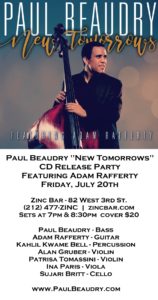It’s been a long time coming but the “New Tomorrows” CD is finally officially coming out! On Friday, July 20th at the Zinc Bar (82 West 3rd St., NYC, www.zincbar.com) sets at 7pm and 8:30pm I’ll be augmenting the original duo of myself and Adam Rafferty on guitar with Kahlil Kwame Bell on percussion and the string quartet of Alan Gruber (violin), Patrisa Tomassini (violin), Ina Paris (viola), and Sujari Britt (cello). Cover is $20. We’ll be playing selections from the new CD and some surprise fun ones!
 As some of you know this recording was intended to be my debut recording but many other (successful) projects came my way and this always ended up on the backburner. Finally I determined this had to happen and I was going to do whatever it takes to see it through. The first recording sessions I did with Adam Rafferty were in my basement in the summer of 2008. When it was clear that what we were doing was quality and my engineering skills were not capturing or doing justice to the music we were playing I decided we had to move the project to a regular studio.
As some of you know this recording was intended to be my debut recording but many other (successful) projects came my way and this always ended up on the backburner. Finally I determined this had to happen and I was going to do whatever it takes to see it through. The first recording sessions I did with Adam Rafferty were in my basement in the summer of 2008. When it was clear that what we were doing was quality and my engineering skills were not capturing or doing justice to the music we were playing I decided we had to move the project to a regular studio.
Engineer Halsey Quemere became my right-hand man as we finished all the duo tracks between two different studios over the next few months. Being that I was an active producer producing recordings for other artists I wanted to try some things that I hadn’t dared try on a client’s record. I loved the tracks that Adam and I had recorded but I kept hearing so much more. After doing a short tour as a sideman with Kahlil Kwame Bell’s band, and since he is a dear friend and one of my favorite percussionists, I asked Kahlil if he could step into the studio and add his brilliant playing to side of the tracks that we recorded. What he did was nothing short of amazing as he was able to lay percussion tracks on top of a bass + guitar duo that hadn’t played along with a click, metronome, or any other sort of timekeeper and the natural rhythm between Adam and I in places had moved around quite a bit.
I was still hearing more. Vocalist, Maya Azucena, and I had become friends having worked with Allan Harris’ Cross That River project. I knew she had the right voice to make the outro of “Lugano” just perfect which she absolutely nailed it. But I was still hearing more. I called violinist, Alan Grubner, another Cross That River alum and we talked about what we could do to add some strings on a few of the songs. The string parts that Alan and I started with went through several revisions before finally there were some arrangements that worked out. I asked Earl Rose to arrange the strings on his original “When Do I Think About You” that Adam and I had recorded. And Adam had written a gem of a song in “America” originally written as an ode to 9/11. For that I went to the master, Gil Goldstein. Gil not only did the “America” arrangement but gave additional advice on the arrangements of “Lugano” and “What Are You Doing” about a week before the string quartet (Chala Yancy, Patrisa Tomassini, Beth Meyers, and Rubin Kodheli) went into the studio to lay everything down with the latest drafts. That session went really well. I was still hearing a little bit more. I wrote a new violin 3 part and asked Grubner to come in and lay down some extra parts. Yes, we’re getting there.
Finally at the mixing phase one tune kept bothering me. There was something missing on “I’ll Always Miss You” which I had actually recorded on Eric Lewis’ debut CD. I called in Gary Versace to add some accordion to give it some mystery and depth. It worked.
Between the mixing, editing, and mastering efforts of John Kilgore, Bennett Paster, and Gene Paul we finally got it done. Here it is! And on July 20th at the Zinc Bar we do it live. I hope you can make it! It will have been a journey worth making. Hope to see you there!



